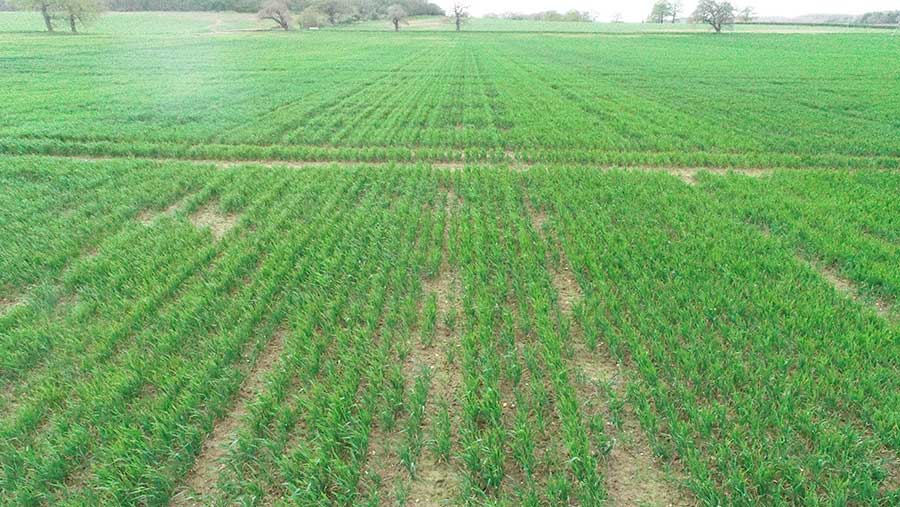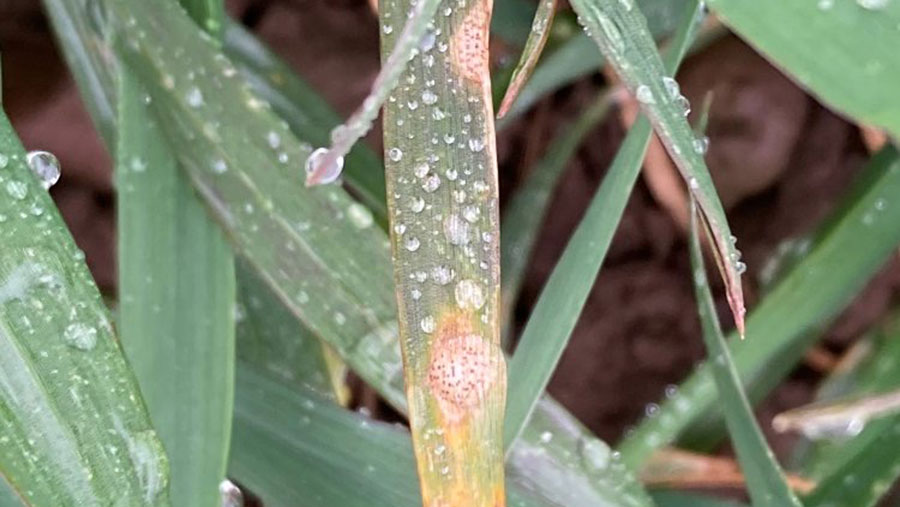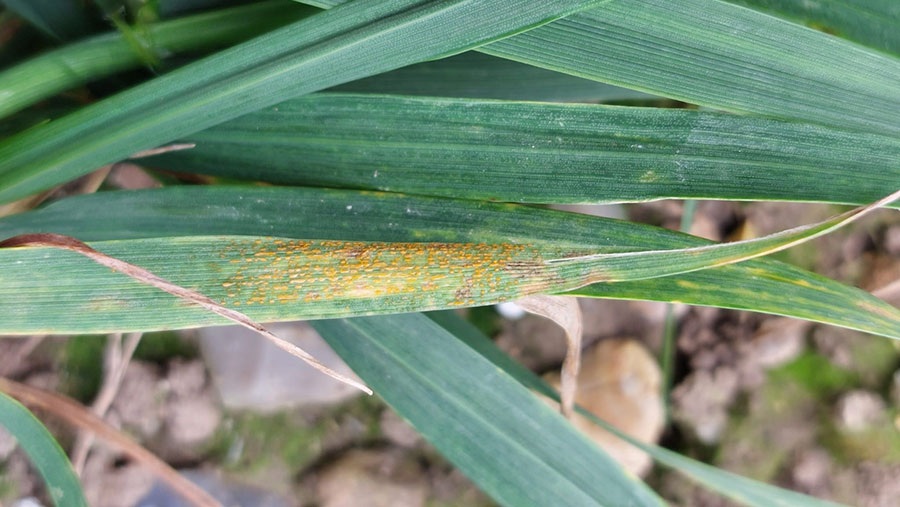Advertiser content
Key considerations for T1 fungicide applications this spring
 © Basf
© Basf Rapidly garnering a reputation as one of the most challenging seasons in decades, the ongoing wet weather means conditions remain difficult to say the least.
With jobs backing up on farm, disease levels rising and many planned T0 applications still in the shed, T1 fungicide decisions will be key this year.
Despite the relentless conditions, it’s encouraging to remember that from a Septoria control perspective, there’s everything still to play for.
With leaf 3 still largely yet to emerge, this means any visual disease symptoms are on leaves with minimal yield contribution and disease control decisions from T1 onwards will strongly influence yield potential.
Andrew Smooker, agronomy manager at Basf said: “There is a similarity between this spring and the last in terms of disease pressure and the limited amount of T0 sprays applied.

Andrew Smooker © Basf
“Septoria is everywhere, even in varieties with very good disease resistance profiles, and, where crops were drilled early, Septoria pressure is high on old leaves. However, leaf 3 will emerge uninfected regardless of the inoculum on the older leaves, and onward disease progression is something that we certainly can have more control over in this unpredictable season.
There is also already plenty of yellow rust and even brown rust to be found too so the overall disease risk is definitely there.”
Efficacy and value
Jared Bonner, business development manager at Basf, said: “This is certainly a year where growers will need a strong, effective, proven product at T1 and Revystar XE (Revysol® + Xemium®) most definitely fits the bill.
“Revystar XE has all-round performance across the key early season diseases; Septoria, yellow and brown rust as well as stem-based infections including eyespot.
Many growers will be concerned that the adverse conditions will have affected yield potential, putting their margins under further intense scrutiny. A robust and well timed T1 application will help protect yield potential and maximise return on investment in this challenging year.
“An application of Revystar XE at 0.75l/ha, the optimum T1 rate, is proven over several years in high-pressure situations and will outperform an application of Ascra at 1.0 l/ha, delivering excellent curative and protectant control and, importantly, value.”
The challenge of variability
On his family farm of Kirkton of Kinellar in Aberdeenshire, where, in common with the rest of the country there has been relentless rain, septoria is the main concern for farmer Scott Campbell.

Scott Campbell © Basf
He said: “Revystar XE will definitely be included in our fungicide programme. It has shown over a number of years it keeps the crop greener and cleaner for longer. It gives us flexibility as it can be used at T1 and T2 timings and you can vary dose rates.”
“It’s been a really challenging season for the growing community, probably the biggest challenge I’ve seen in my farming career, and probably dad’s generation as well.”
Winter wheat crops, in Aberdeenshire and across the UK, faced extremely adverse establishment conditions which has led to the current huge variability in fields and plant stands, leaving growers facing an agronomically challenging season.
Jared said: “Whilst it is always important for growers to target leaf 3 for their T1, this year because of crop variability growers should carry out apical dissections to identify which leaf is present.
“Applications in winter wheat are best aimed at the point when two thirds of target leaves are fully emerged.”
To further complicate matters, recent Niab research found leaf layer emergence varies considerably across years, field sites and varieties. In some varieties leaf layers can take 14 days to emerge.
“The length of time a leaf layer takes to emerge will dictate how long leaves are unprotected and exposed to disease.
“Revystar XE is a strong product which is highly effective against septoria in both curative and protectant situations, the scenario growers will likely be facing in the field this season at T1.

© Basf
“If the weather remains challenging, then controlling disease on leaf 2 will be critical.
“Revystar XE is proven to not only delay the septoria epidemic on treated leaves but also to slow the infection on emerging leaves, in this case leaf 2. It has been proven on farm for a number of seasons and in a variety of conditions, performing well on crops which are at variable growth stages, protecting both the targeted leaf layer and soon to emerge leaves,” added Jared.
Rusts and eyespot
In what could be a year where spray days are few and far between, Revystar® XE gives growers flexibility – both with spray application water volumes and tank mix partners.
Jared said: “Both Xemium and Revysol have strong activity on rusts and the combination within Revystar XE gives a high level of rust control.
“There is, however, the opportunity where T0s were missed in susceptible varieties and yellow rust is a target, to add tebuconazole, probably already on farm, in with 0.75l/ha Revystar XE to add additional suppression of any already established inoculum.”

© Basf
With spring conditions conducive to eyespot development, growers should monitor their crops for this disease around GS 30/31.
“A Revystar XE programme will deliver a good level of eyespot control, giving strong suppression of both strains of the pathogen.
“This means there is no need to move to a prothioconazole-based programme if you are worried about eyespot. Its two effective active ingredients of Xemium and Revysol will do a robust job,” said Jared.
Resistance management
Resistance development associated with the use of fungicides is a well-known risk to effective disease control.
In order to achieve effective resistance management, it is important for growers to consider which active ingredients are contained within the products in their fungicide programmes and their modes of action.
“Revystar XE contains Revysol, the only triazole offering strong efficacy for the control of Septoria and a key active to include in programmes to support sustainable septoria control.
“It’s an important active from a resistance management point of view, helping to maintain the effective life of available products for as long as possible,” added Jared.
Weather resilience
Recent UK weather patterns have certainly been unpredictable, and fungicide performance must be resilient in the face of these changeable conditions.
Revystar ® XE has outstanding uptake and performance under cool conditions and, of particularly relevance this season, very fast leaf uptake, with trials showing minimal losses even following heavy rain just 15 minutes after application.
This rapid foliar uptake ensures Revystar® XE is also effectively protected from degradation by UV radiation even in high levels of sunlight.
Find out more about how things are looking on Scott’s farm this spring and his disease control strategy here.
Provided by
BASF offers renowned and innovative fungicides, herbicides, insecticides and growth regulators for agriculture. Our products and services help farmers increase their yields and optimize the quality of their products.
